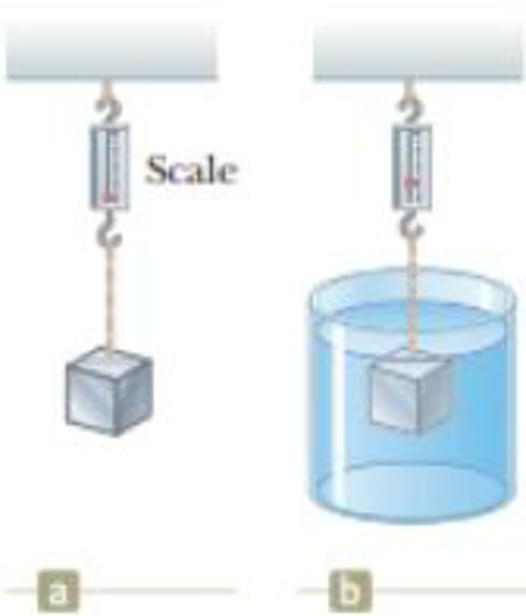
Concept explainers
A 10.0-kg block of metal measuring 12.0 cm by 10.0 cm by 10.0 cm is suspended from a scale and immersed in water as shown in Figure P14.11b. The 12.0-cm dimension is vertical, and the top of the block is 5.00 cm below the surface of the water. (a) What are the magnitudes of the forces acting on the top and on the bottom of the block due to the surrounding water? (b) What is the reading of the spring scale? (c) Show that the buoyant force equals the difference between the forces at the top and bottom of the block.
Figure P14.11 Problems 11 and 12.

(a)
The magnitudes of the forces acting on the top and on the bottom of the block due to the surrounding water.
Answer to Problem 27P
The magnitudes of the forces acting on the top and on the bottom of the block due to the surrounding water is
Explanation of Solution
Section 1:
To determine: The magnitudes of the force acting on the top of the block due to the surrounding water.
Answer: The magnitudes of the force acting on the top of the block due to the surrounding water is
Given information:
The mass of the block is
Formula to calculate the absolute pressure at the top of the block is,
Formula to calculate the force acting on the top of the block is,
Substitute
Substitute
Conclusion:
Therefore, the magnitudes of the force acting on the top of the block due to the surrounding water is
Section 2:
To determine: The magnitudes of the force acting on the bottom of the block due to the surrounding water.
Answer: The magnitudes of the force acting on the bottom of the block due to the surrounding water is
Given information:
The mass of the block is
Formula to calculate the absolute pressure at the bottom of the block is,
Formula to calculate the force acting on the bottom of the block is,
Substitute
Substitute
Conclusion:
Therefore, the magnitudes of the force acting on the bottom of the block due to the surrounding water is
(b)
The reading of the spring scale.
Answer to Problem 27P
The reading in the spring scale is
Explanation of Solution
Given information:
The mass of the block is
The scale reading when the block is immersed in water is equal to the tension in the chord supporting the block.
Apply the equilibrium condition.
Rearrange the above equation for
Substitute
Conclusion:
Therefore, the reading in the spring scale is
(c)
To show: That the buoyant force equals the difference between the force at the top and bottom of the block.
Explanation of Solution
Given information:
The mass of the block is
When an object is immersed in a liquid, then the upward force exerted on it by fluid is called buoyant force and its magnitude equals the weight of the liquid displaced by the object.
Formula to calculate the buoyant force is,
Substitute
From part (a), the difference between the force at the top and bottom of the block is,
From the above calculations it is clear that,
Conclusion:
Therefore, the buoyant force equals the difference between the force at the top and bottom of the block.
Want to see more full solutions like this?
Chapter 14 Solutions
Bundle: Physics for Scientists and Engineers with Modern Physics, Loose-leaf Version, 9th + WebAssign Printed Access Card, Multi-Term
- RT = 4.7E-30 18V IT = 2.3E-3A+ 12 38Ω ли 56Ω ли r5 27Ω ли r3 28Ω r4 > 75Ω r6 600 0.343V 75.8A Now figure out how much current in going through the r4 resistor. |4 = unit And then use that current to find the voltage drop across the r resistor. V4 = unitarrow_forward7 Find the volume inside the cone z² = x²+y², above the (x, y) plane, and between the spheres x²+y²+z² = 1 and x² + y²+z² = 4. Hint: use spherical polar coordinates.arrow_forwardганм Two long, straight wires are oriented perpendicular to the page, as shown in the figure(Figure 1). The current in one wire is I₁ = 3.0 A, pointing into the page, and the current in the other wire is 12 4.0 A, pointing out of the page. = Find the magnitude and direction of the net magnetic field at point P. Express your answer using two significant figures. VO ΜΕ ΑΣΦ ? Figure P 5.0 cm 5.0 cm ₁ = 3.0 A 12 = 4.0 A B: μΤ You have already submitted this answer. Enter a new answer. No credit lost. Try again. Submit Previous Answers Request Answer 1 of 1 Part B X Express your answer using two significant figures. ΜΕ ΑΣΦ 0 = 0 ? below the dashed line to the right P You have already submitted this answer. Enter a new answer. No credit lost. Try again.arrow_forward
 Principles of Physics: A Calculus-Based TextPhysicsISBN:9781133104261Author:Raymond A. Serway, John W. JewettPublisher:Cengage Learning
Principles of Physics: A Calculus-Based TextPhysicsISBN:9781133104261Author:Raymond A. Serway, John W. JewettPublisher:Cengage Learning Physics for Scientists and Engineers with Modern ...PhysicsISBN:9781337553292Author:Raymond A. Serway, John W. JewettPublisher:Cengage Learning
Physics for Scientists and Engineers with Modern ...PhysicsISBN:9781337553292Author:Raymond A. Serway, John W. JewettPublisher:Cengage Learning Physics for Scientists and Engineers: Foundations...PhysicsISBN:9781133939146Author:Katz, Debora M.Publisher:Cengage Learning
Physics for Scientists and Engineers: Foundations...PhysicsISBN:9781133939146Author:Katz, Debora M.Publisher:Cengage Learning Physics for Scientists and EngineersPhysicsISBN:9781337553278Author:Raymond A. Serway, John W. JewettPublisher:Cengage Learning
Physics for Scientists and EngineersPhysicsISBN:9781337553278Author:Raymond A. Serway, John W. JewettPublisher:Cengage Learning College PhysicsPhysicsISBN:9781285737027Author:Raymond A. Serway, Chris VuillePublisher:Cengage Learning
College PhysicsPhysicsISBN:9781285737027Author:Raymond A. Serway, Chris VuillePublisher:Cengage Learning College PhysicsPhysicsISBN:9781938168000Author:Paul Peter Urone, Roger HinrichsPublisher:OpenStax College
College PhysicsPhysicsISBN:9781938168000Author:Paul Peter Urone, Roger HinrichsPublisher:OpenStax College





